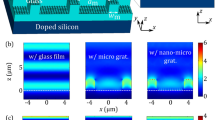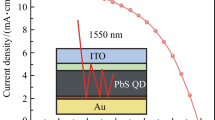Abstract
In this article, a novel photovoltaic/thermal (PV/T) geometry is introduced that allows for passive microlensing, IR collection, and photovoltaic deployment, as in previous implementations, together with spectral splitting. Stokes shifting dyes of the Coumarin family were dispersed in a thermal fluid in front of a single-junction amorphous silicon PV using a tubular focusing geometry. This architecture effectively shifts the high-energy UV flux into near bandgap photons for the Si, while capturing the released energy of the Stokes transition as heat. By combining this with the thermal fluid’s IR absorption and the PV, the system converts a surprising amount of the solar flux into collectable power, with a 71.05% thermal conversion efficiency and 2.07% electrical efficiency, leading to a total system efficiency of conversion of 73.1 percent. Temperatures and heat flow were then simulated to connect optical characteristics to thermal transport characteristics and allow for optimization under various circumstances.
Impact statement
The large entry cost of solar makes it unattainable for large segments of the world’s population. In this article, we present a photovoltaic/thermal (PV/T) system, made of low-cost, easily accessible materials that are simple to manufacture. Together, the components of the system harvest energy from nearly the entire solar spectrum using a photovoltaic, infrared absorbing thermal fluid and a Stokes shifting dye. The geometry of the PV/T acts as a passive microlens system while providing the additional benefit of keeping the PV cool. The modeling presented allows for optimization in specific applications.
Graphical abstract






Similar content being viewed by others
Data availability
The data sets generated during this study are available from the corresponding author on reasonable request.
Code availability
The code generated during this study is available from the corresponding author on reasonable request.
References
Renewables 2021 Global Status Report (REN21, 2021)
W. Shockley, H.J. Queisser, J. Appl. Phys. 32, 510 (1961). https://doi.org/10.1063/1.1736034
T. Trupke, M.A. Green, P. Würfel, J. Appl. Phys. 92, 1668 (2002). https://doi.org/10.1063/1.1492021
H.J. Hovel, R.T. Hodgson, J.M. Woodall, Sol. Energy Mater. 2, 19 (1979). https://doi.org/10.1016/0165-1633(79)90027-3
B.-C. Hong, K. Kawano, Jpn. J. Appl. Phys. 43, 1421 (2004). https://iopscience.iop.org/article/10.1143/JJAP.43.1421
D.E. Osborn, M.A.C. Chendo, M.A. Hamdy, F. Luttmann, M.R. Jacobson, H.A. Macleod, R. Swenson, Sol. Energy Mater. 14, 299 (1986). https://doi.org/10.1016/0165-1633(86)90055-9
J.D. McCambridge, M.A. Steiner, B.L. Unger, K.A. Emery, E.L. Christensen, M.W. Wanlass, A.L. Gray, L. Takacs, R. Buelow, T.A. McCollum, J.W. Ashmead, G.R. Schmidt, A.W. Haas, J.R. Wilcox, J. Van Meter, J.L. Gray, D.T. Moore, A.M. Barnett, R.J. Schwartz, Prog. Photovolt. Res. Appl. 19, 352 (2011). https://doi.org/10.1002/pip.1030
R. Cariou, J. Benick, F. Feldmann, O. Höhn, H. Hauser, P. Beutel, N. Razek, M. Wimplinger, B. Bläsi, D. Lackner, M. Hermle, G. Siefer, S.W. Glunz, A.W. Bett, F. Dimroth, Nat. Energy 3, 326 (2018). https://doi.org/10.1038/s41560-018-0125-0
N.H. Vu, T.T. Pham, S. Shin, Energies 13, 2360 (2020). https://doi.org/10.3390/en13092360
G. Huang, S.R. Curt, K. Wang, C.N. Markides, Nano Mater. Sci. 2(3), 183 (2020). https://doi.org/10.1016/j.nanoms.2020.03.008
F.Sh. Zainulabdeen, A.H. Al-Hamdani, G.S. Karam, J.H. Ali, AIP Conf. Proc. 2190, 020054 (2019). https://doi.org/10.1063/1.5138540
X. Ju, C. Xu, X. Han, X. Du, G. Wei, Y. Yang, Appl. Energy 187, 534 (2017). https://doi.org/10.1016/j.apenergy.2016.11.087
H. Ramdani, C. Ould-Lahoucine, Energy Convers. Manag. 222, 113238 (2020). https://doi.org/10.1016/j.enconman.2020.113238
W.A.M. Al-Shohani, R. Al-Dadah, S. Mahmoud, Appl. Therm. Eng. 109, 475 (2016). https://doi.org/10.1016/j.applthermaleng.2016.08.107
X. Han, L. Tu, Y. Sun, Sol. Energy 223, 168 (2021). https://doi.org/10.1016/j.solener.2021.05.039
M. Vaka, R. Walvekar, A.K. Rasheed, M. Khalid, H. Panchal, IEEE Access 8, 58227 (2020). https://doi.org/10.1109/ACCESS.2019.2950384
S. Aberoumand, S. Ghamari, B. Shabani, Sol. Energy 165, 167 (2018). https://doi.org/10.1016/j.solener.2018.03.028
Y. Li, E.D. Peterson, H. Huang, M. Wang, D. Xue, W. Nie, W. Zhou, D.L. Carroll, Appl. Phys. Lett. 96, 243505 (2010). https://doi.org/10.1063/1.3453757
H. Huang, Y. Li, M. Wang, W. Nie, W. Zhou, E.D. Peterson, J. Liu, G. Fang, D.L. Carroll, Sol. Energy 85, 450 (2011). https://doi.org/10.1016/j.solener.2010.12.011
L.J. Gray, C. Griffin, W. Wolszczak, P. Allaire, D.L. Carroll, J. Renew. Sustain. Energy 13, 069101 (2021). https://doi.org/10.1063/5.0065592
U. Raikar, C.G. Renuka, Y.F. Nadaf, B.G. Mulimani, A.M. Karguppikar, M.K. Soudagar, Spectrochim. Acta A 65, 673 (2006). https://doi.org/10.1016/j.saa.2005.12.028
M. Hetmańska, A. Maciejewski, RSC Adv. 7, 44843 (2017). https://doi.org/10.1039/C7RA05051H
R. Biswas, J.E. Lewis, M. Maroncelli, Chem. Phys. Lett. 310, 485 (1999). https://doi.org/10.1016/S0009-2614(99)00838-6
F. Sobhnamayan, F. Sarhaddi, M.A. Alavi, S. Farahat, J. Yazdanpanahi, Renew. Energy 68, 356 (2014). https://doi.org/10.1016/j.renene.2014.01.048
I. Karaaslan, T. Menlik, Sol. Energy 224, 1260 (2021). https://doi.org/10.1016/j.solener.2021.06.072
E. Skoplaki, J.A. Palyvos, Sol. Energy 83, 614 (2009). https://doi.org/10.1016/j.solener.2008.10.008
B.J. Fontenault, E. Gutierrez-Miravete, “Modeling a Combined Photovoltaic-Thermal Solar Panel,” in Proceedings of 2012 COMSOL Conference (Boston, 2012). https://www.semanticscholar.org/paper/Modeling-a-Combined-Photovoltaic-Thermal-Solar-Fontenault-Gutierrez-Miravete/8b4b6dccb80b94f1a9a4a77a745b62c7bc332f87. Accessed 29 Jul 2022
Acknowledgments
The authors would like to thank Laxman Poudel of WFU Physics and Anthony Le of WFU Chemistry for assistance with the spectroscopy measurements. The authors would also like to thank E. Chapman for assistance with handling of the glass tubes and D. Stieler for help with the quantum efficiency of the photovoltaic.
Funding
This work was supported by the Center for Nanotechnology and Molecular Materials at Wake Forest University.
Author information
Authors and Affiliations
Contributions
Authors contributed equally to this work.
Corresponding author
Ethics declarations
Conflict of interest
On behalf of all authors, the corresponding author states that there is no conflict of interest.
Ethical approval
Not applicable.
Consent to participate
Not applicable.
Consent for publication
Not applicable.
Additional information
Publisher's Note
Springer Nature remains neutral with regard to jurisdictional claims in published maps and institutional affiliations.
Supplementary information
Below is the link to the electronic supplementary material.
Rights and permissions
Springer Nature or its licensor (e.g. a society or other partner) holds exclusive rights to this article under a publishing agreement with the author(s) or other rightsholder(s); author self-archiving of the accepted manuscript version of this article is solely governed by the terms of such publishing agreement and applicable law.
About this article
Cite this article
Gray, L.J., Buna, D., Ucer, K.B. et al. Incorporation of Stokes shifting dyes into a Si-based photovoltaic thermal system. MRS Bulletin 48, 449–458 (2023). https://doi.org/10.1557/s43577-022-00444-w
Accepted:
Published:
Issue Date:
DOI: https://doi.org/10.1557/s43577-022-00444-w




